The diagram ahead shows an object AB placed on the principal axis of a lens L. The two foci of the lens are F1 and F2. The image formed by the lens is erect, virtual and diminished.
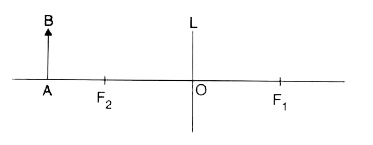
(i) Draw the outline of the lens L used and name it.
(ii) Draw a ray of light starting from B and passing through O. Show the same ray after refraction by the lens.
(iii) Draw another ray from B which is incident parallel to the principal axis and show how does it emerge after refraction from the lens.
(iv) Locate the final image formed.
(i) Since the image formed by the lens is erect, virtual and diminished, the lens is concave. The outline of the lens L is shown in Fig.
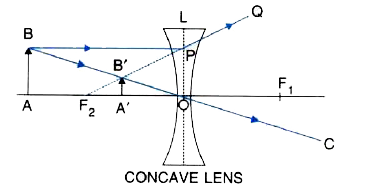
(ii) The light ray BO is incident at the optical centre O of the lens, so it passes undeviated as OC after refraction through the lens.
(iii) The light ray BP is incident parallel to the principal axis. It emerges as PQ after refraction which appears to diverge from the second focus F2 of the lens.
(iv) The refracted rays OC and PQ do not actually meet, but they appear to diverge from a point B. (i.e., they meet at a point B. when they are produced backwards). Thus B. is the virtual image of the point B. The complete image A.B. is obtained by drawing a perpendicular from B. on the line F2OF1. The image is formed between the optical centre O and focus F2 of the lens. The completed ray diagram is shown in Fig.
Topper's Solved these Questions
- REFRACTION THROUGH A LENS BOOK - ICSECHAPTER - REFRACTION THROUGH A LENS EXERCISE - EXERCISE-5(A)
12 Videos
- REFRACTION THROUGH A LENS BOOK - ICSECHAPTER - REFRACTION THROUGH A LENS EXERCISE - EXERCISE-5(A) (MULTIPLE CHOICE TYPE)
2 Videos
- REFRACTION OF LIGHT AT PLANE SURFACESBOOK - ICSECHAPTER - REFRACTION OF LIGHT AT PLANE SURFACESEXERCISE - EXERCISE-4(D) MULTIPLE CHOICE TYPE
3 Videos
- REFRACTION THROUGH LENSBOOK - ICSECHAPTER - REFRACTION THROUGH LENSEXERCISE - NUMERICAL BASED MCQ:
10 Videos
Similar Questions
In the case of a convex lens, show the path of the refraction ray when the incident ray of light (1) is parallel to the principal axis of the lens (2) passes through the focus of the lens (3) passes through the optical centre of the lens.
View SolutionShow by drawing a ray-diagram that the image of an object formed by a concave lens is virtual, erect and diminished.
View SolutionAn object is placed in front of a lens between its optical centre and the focus and forms a virtual, erect and diminished image.
Draw a ray diagram to show the formation of the image with the above stated characteristics.
View SolutionAn object AB is placed between 2F, and F, on the principal axis of a convex lens as shown in the diagram.
Copy the diagram and using three rays starting from point A, obtain the image of the object formed by the lens.
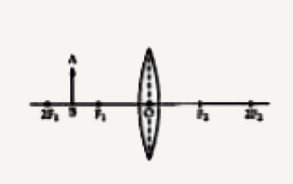
View SolutionAn object 10 cm tall is placed on the principal axis of a concave lens of focal length 10 cm at a distance of 15 cm from it. Find the position and nature of the image formed by the lens and draw the ray diagram.
View SolutionAn object AB is placed between 2F1andF1 on the principal axis of a convex lens as shown in the diagram :
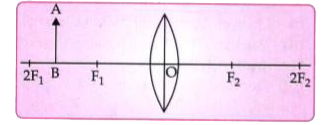
Copy the diagram and using three rays starting from point A, obtain the image of the object formed by the lens.
View SolutionAn object AB is placed between O and F1 on the principal axis of a converging lens as shown in the diagram. Copy the diagram and by using three standard rays starting from point A, obtain an image of the object AB.
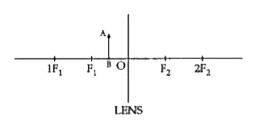
View SolutionAn object AB is placed between O and F1 on the principal axis of a converging lens as shown in the diagram.
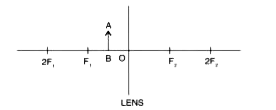
Copy the diagram and by using three standard rays starting from point A, obtain an image of the object AB.
View SolutionA lens forms an erect, magnified and virtual image of an object.
Name the lens.
View SolutionA : The image formed by a concave lens is always virtual.
R : The rays emerging from a concave lens never meet on the principal axis.
View Solution
